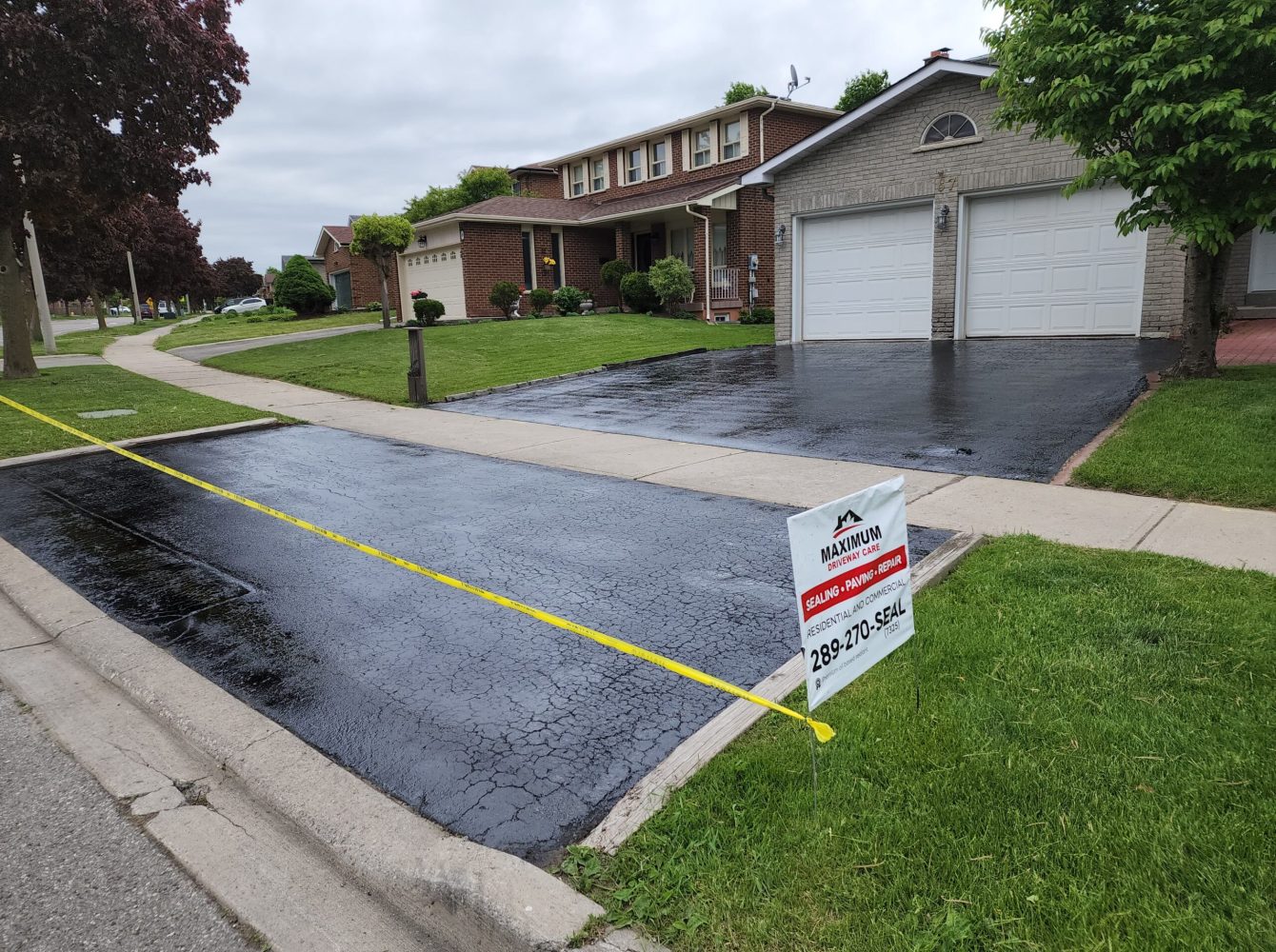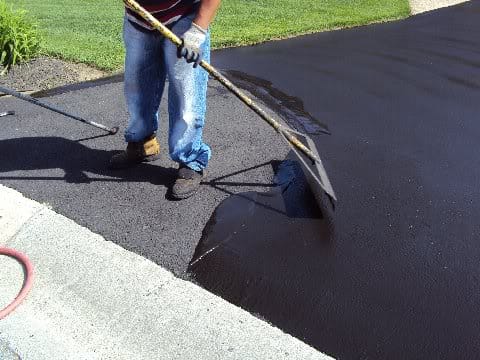Renew Your Home with Regrading and Asphalt Sealing Methods
Renew Your Home with Regrading and Asphalt Sealing Methods
Blog Article
Hot Mix Asphalt: A Sustainable Remedy for Pavement
Hot Mix Asphalt (HMA) has actually arised as a leading sustainable option for sidewalk solutions, supplying a myriad of innovative technologies and ecological benefits. As the demand for environmentally friendly building methods grows, checking out the subtleties of HMA's sustainability can supply valuable insights into the future of sidewalk remedies.
Ecological Advantages of Hot Mix Asphalt

Moreover, Hot Mix Asphalt assists to reduce urban warm island impacts. Its dark shade takes in sunshine, decreasing the amount of warmth mirrored back right into the ambience contrasted to lighter-colored pavements. This can lower ambient temperature levels in metropolitan areas, reducing the demand for cooling and inevitably reducing power consumption.
Furthermore, Hot Mix Asphalt adds to improved stormwater administration. Its permeable nature permits water to infiltrate the pavement and recharge groundwater products, lowering runoff and the threat of flooding. These environmental benefits make Hot Mix Asphalt a lasting choice for leading roadways and freeways.
Energy Efficiency in HMA Production
Is power effectiveness a crucial element in the production of Warm Mix Asphalt (HMA)? Power plays a substantial function in the manufacturing of HMA, impacting both expense and environmental sustainability. One essential facet of power efficiency in HMA production is the usage of warm mix asphalt (WMA) innovations.
Additionally, innovations in plant innovations have actually led to more energy-efficient HMA production procedures. By optimizing energy use in HMA manufacturing, the market can reduce its carbon impact while keeping premium pavement materials.
Recyclability of Warm Mix Asphalt
The recyclability of Warm Mix Asphalt (HMA) is a pivotal element of its sustainability and long-term environmental effect. HMA is just one of the most recycled products in the USA, with over 100 million heaps of redeemed asphalt pavement (RAP) being reused yearly in brand-new sidewalk construction. Recycling HMA uses numerous ecological advantages, such as minimizing the requirement for virgin products, reducing energy intake during manufacturing, and reducing the amount of waste sent to landfills.
The procedure of recycling HMA involves grating the existing pavement, squashing it right into smaller sized pieces, and mixing it with brand-new accumulation and asphalt binder to produce a recycled mix. This recycled mix can usually carry out as well as or also much better than conventional HMA, while needing less resources and producing reduced greenhouse gas exhausts. By incorporating RAP right into brand-new pavement jobs, roadway firms can save natural resources, reduce expenses, and decrease the ecological impact of roadway building and upkeep activities. Generally, the recyclability of HMA plays a substantial role in promoting lasting techniques within the sidewalk market.

Long-Term Performance of HMA
Asphalt pavements demonstrate resilience and strength over an extensive period, mirroring the long-term performance of Hot Mix Asphalt (HMA) The long life of HMA can be associated to its ability to endure rush hour tons, harsh weather condition conditions, and the effects of aging. Studies have actually revealed that properly designed and properly built HMA sidewalks can last for two decades or even more with normal maintenance. The key to making best use of the lasting performance of HMA hinges on using top notch materials, adhering to best techniques in construction, and implementing efficient upkeep strategies. Correct drainage, routine evaluations, and timely repairs are necessary for preserving the architectural hot mix asphalt honesty of HMA sidewalks in time. In addition, advancements in HMA modern technology, such as using polymer-modified binders and warm mix asphalt, have better boosted the sturdiness and durability of HMA pavements. By focusing on quality building and maintenance techniques, HMA remains to show itself as a lasting and cost-effective remedy for durable sidewalk facilities.

HMA: Longevity and Sustainability
Demonstrating both sturdiness and sustainability, Warm Mix Asphalt (HMA) has become a foundation in the construction of lasting pavement frameworks - angled parking. HMA's longevity originates from its capacity to endure hefty tons, harsh weather, and high traffic quantities, making it a dependable option for roads, freeways, and airport paths. The composition of HMA, which normally consists of accumulations, binder, and filler, plays a vital function in enhancing its durability and resistance to use and tear
Moreover, HMA's sustainability lies in its recyclability and energy-efficient production procedure. The capacity to recycle reclaimed asphalt pavement (RAP) in new HMA mixes lowers the demand for virgin materials and lessens the ecological influence of pavement construction and upkeep. Additionally, the power efficiency of creating HMA exists in its reduced mixing temperatures compared to various other pavement materials, bring about reduced power consumption and greenhouse gas emissions.
Final Thought
To conclude, hot mix asphalt (HMA) provides a lasting remedy for pavement with its ecologically friendly attributes. HMA's recyclability, power effectiveness in production, and lasting longevity make it an eco-friendly choice for roadway building and construction. By conserving all-natural resources, decreasing waste, and lowering greenhouse gas exhausts, HMA plays a vital role in advertising sustainability in infrastructure development. Its ability to minimize city warmth island impacts further emphasizes its significance in developing resistant and environmentally aware pavement systems.
HMA is one of the most recycled materials in the her comment is here United States, with over 100 million bunches of recovered asphalt sidewalk (RAP) being recycled yearly in new sidewalk construction.The process of recycling HMA involves crushing the existing sidewalk, squashing it into smaller sized pieces, and mixing it with new accumulation and asphalt binder to develop a recycled mix.Asphalt sidewalks show sturdiness and resilience over an extended a knockout post duration, showing the long-lasting performance of Hot Mix Asphalt (HMA) In addition, advancements in HMA technology, such as the usage of polymer-modified binders and cozy mix asphalt, have even more improved the longevity and long life of HMA sidewalks. The capacity to reuse reclaimed asphalt sidewalk (RAP) in brand-new HMA mixes lowers the need for virgin products and reduces the ecological effect of sidewalk construction and upkeep.
Report this page